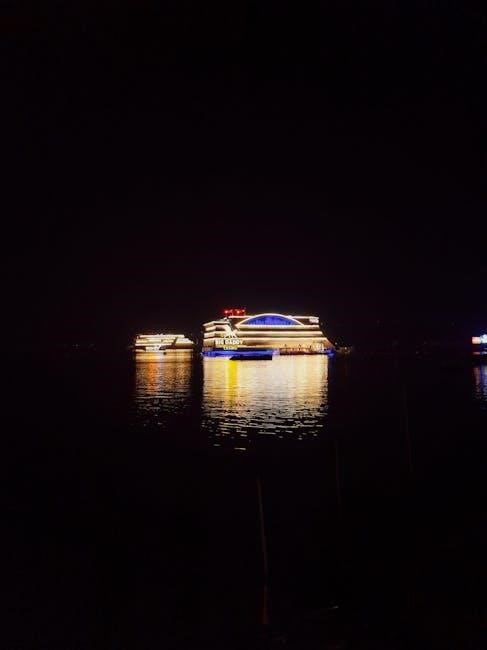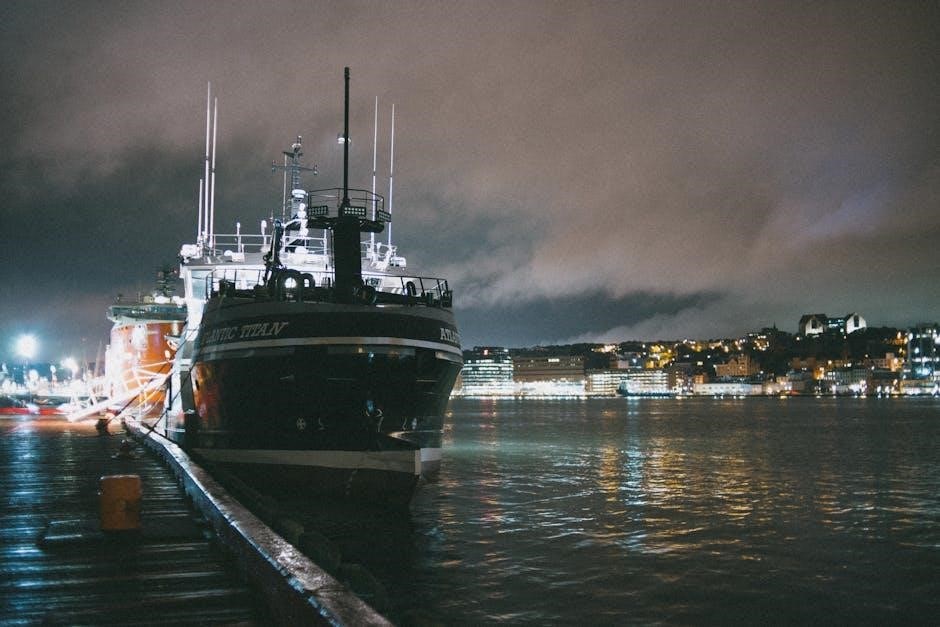Navigation lights are essential for maritime safety, preventing collisions by indicating a vessel’s position, size, and direction. They must comply with COLREGs and Inland Navigation Rules to ensure visibility and clear communication between vessels at night or in low visibility conditions. Properly configured lights help avoid accidents and are a critical component of safe navigation practices globally.
Overview of Navigation Lights
Navigation lights are standardized visual signals used by vessels to communicate their position, direction, and status to other mariners. They include masthead lights, sidelights, and sternlights, each with specific visibility arcs and intensities. These lights are categorized based on vessel type, such as power-driven, sailing, or special-purpose vessels like pilot or towing boats. Compliance with international and inland rules ensures safety and prevents collisions, making them a cornerstone of maritime communication and safety protocols globally.
Importance of Navigation Lights in Maritime Safety
Navigation lights are critical for preventing collisions and ensuring maritime safety. They provide visual cues about a vessel’s position, direction, and operational status, enabling other mariners to make informed decisions. Properly displayed lights reduce the risk of accidents, especially in low visibility conditions. Compliance with regulations is mandatory, as failure to display correct lights can lead to legal consequences and heightened safety risks. Their reliability and simplicity make them indispensable in maintaining safe navigation practices worldwide.
Regulations Governing Navigation Lights
Navigation lights are governed by COLREGs and Inland Navigation Rules, ensuring standardized lighting systems to prevent collisions and enhance maritime safety globally. Compliance is mandatory for all vessels.
COLREGs (Convention on the International Regulations for Preventing Collisions at Sea)
The COLREGs, established by the International Maritime Organization (IMO), provide comprehensive rules for navigation lights to prevent collisions. They specify the types, placement, and visibility of lights for different vessel types and sizes. Compliance with COLREGs is mandatory for all vessels engaged in international navigation, ensuring uniformity in maritime safety standards. These regulations are regularly updated to reflect advancements in technology and evolving maritime practices, ensuring ongoing safety at sea.
Inland Navigation Rules (33 CFR Subchapter E)
The Inland Navigation Rules (33 CFR Subchapter E) govern vessel navigation on U.S. inland waters, including rivers and lakes. These rules specify lighting requirements for different vessel types, ensuring safe operations in diverse environments. They complement COLREGs, with specific provisions for inland conditions. Vessels must display appropriate lights during darkness or low visibility, adhering to these rules to maintain safety and prevent collisions in inland waterways. Compliance is enforced by U.S. authorities to protect maritime traffic and the environment.
Technical Specifications of Navigation Lights
Navigation lights must meet strict technical standards, including intensity, visibility arcs, and power supply requirements. Masthead, sidelights, and sternlights are designed to ensure clear visibility and proper signaling.
Types of Navigation Lights (Masthead, Sidelights, Sternlight)
Navigation lights include masthead, sidelights, and sternlight. Masthead lights are white, positioned forward, indicating the vessel’s direction. Sidelights are green (starboard) and red (port), showing the vessel’s sides. Sternlights are white, located aft, signaling the vessel’s rear. These lights are essential for visibility and signaling, ensuring safe navigation at night or in reduced visibility. Proper configuration and placement are critical to avoid collisions and comply with maritime regulations.
Visibility Arcs and Intensity Standards
Navigation lights must meet specific visibility and intensity standards to ensure clarity. Masthead lights have a 225° arc, sidelights 112.5°, and sternlights 135°. Intensity must not exceed 100 candelas to avoid glare. These standards ensure lights are visible from required distances without causing interference. Proper intensity and arc coverage are critical for safe navigation, enabling vessels to signal their position and direction effectively. Compliance with these standards is essential for maritime safety and collision prevention.

Installation and Placement Requirements
Navigation lights must be installed at specified heights and positions to ensure visibility. Masthead lights are mounted at least 2.5 meters above the gunwale, while sidelights and sternlights are positioned to maximize visibility from all directions. Correct installation ensures compliance with safety standards and prevents collisions at sea.
Height and Positioning of Navigation Lights
Navigation lights must be installed at specific heights and positions to ensure optimal visibility. Masthead lights are mounted at least 2.5 meters above the gunwale, while sidelights are positioned to ensure visibility from the side. Sternlights are placed at the stern, and all lights must be unobstructed to avoid glare. Correct positioning ensures compliance with safety standards, maximizing visibility for other vessels and reducing collision risks.
Power Supply and Emergency Power Requirements
Navigation lights require a reliable power supply to ensure continuous operation. Vessels must have both main and emergency power sources to maintain light functionality. Battery-powered backups are essential, with circuit protection to prevent overloading. Emergency systems must automatically activate if the main power fails. These requirements ensure uninterrupted visibility, critical for safety in low-light conditions. Compliance with these standards is mandated by COLREGs and inland navigation rules to guarantee vessel safety and regulatory adherence at all times.
Navigation Lights for Different Types of Vessels
Navigation light requirements vary by vessel type, size, and operational status. Sailing vessels, power-driven boats, and special-purpose ships each have distinct lighting standards to ensure safe operation.
Navigation Lights for Sailing Vessels
Sailing vessels under 20 meters must display specific navigation lights to ensure visibility and safety. They can use combined sidelights and a sternlight or separate lights if preferred. Vessels over 20 meters require a masthead light, sidelights, and a sternlight. When motoring, sailing vessels must show power-driven vessel lights. Visibility arcs and intensity standards must be met to avoid collisions. Sails should be visible during the day, replacing day shapes. Proper lighting ensures clear communication of a vessel’s status to others at sea.
Navigation Lights for Power-Driven Vessels
Power-driven vessels must display specific navigation lights to ensure safe operation. A masthead light, visible over 225 degrees, is required for vessels over 50 meters, while those under 50 meters may use a shorter arc. Sidelights (red on port, green on starboard) and a sternlight are mandatory. The masthead light must be positioned at least 2.5 meters above the deck on larger vessels. Proper visibility and compliance with COLREGs are critical to avoid collisions and ensure safe maritime operations.
Special Purpose Vessels (Pilot Vessels, Towing Vessels)
Special purpose vessels, such as pilot and towing vessels, require distinct navigation lights. Pilot vessels must display a white light above a red light vertically while underway. Towing vessels exhibit two masthead lights in a vertical line instead of the standard masthead light. These configurations ensure clear identification and safe operation. Compliance with COLREGs is essential to maintain maritime safety and prevent collisions, especially during specialized operations requiring unique lighting configurations. Proper display of these lights is crucial for clear communication and operational safety at sea.

Operating Requirements for Navigation Lights
Navigation lights must be displayed between sunset and sunrise or in restricted visibility. Proper operation ensures visibility and compliance with COLREGs, enhancing maritime safety and preventing collisions. Adherence is mandatory for all vessels to maintain clear communication and operational safety at sea. Lights should function reliably without excessive glare, ensuring other vessels can interpret signals accurately. Regular checks and adherence to power supply requirements are essential for uninterrupted operation. This ensures continuous safety and visibility in all conditions, reducing the risk of accidents. Compliance is critical for safe navigation and legal operation.
When to Display Navigation Lights
Navigation lights must be displayed between sunset and sunrise or in conditions of restricted visibility. This ensures vessels are visible to others, reducing collision risks. All vessels, regardless of size, must comply with these requirements. Proper timing and visibility adherence are critical for maritime safety. Failure to display lights during these periods can lead to accidents and legal consequences. Clear visibility ensures other vessels can interpret signals accurately, maintaining safe navigation practices globally. Compliance is essential for operational safety at sea.
Proper Use of Colors and Light Combinations
Navigation lights use specific colors and combinations to communicate a vessel’s type, size, and direction. Green indicates starboard, red port, and white stern or masthead lights. Power-driven vessels display a white masthead light forward, green starboard, red port, and white sternlight. Sailing vessels show a white sternlight and red/green sidelights. Special vessels, like pilot or towing boats, use unique combinations, such as white over red lights for pilot vessels; Correct color usage ensures clear communication, preventing collisions and enhancing maritime safety. Adherence to these standards is critical for effective navigation.

Maintenance and Compliance
Regular inspection and testing of navigation lights ensure reliability and compliance with COLREGs. Proper maintenance includes cleaning, alignment checks, and timely replacement of faulty components to avoid violations.
Regular Inspection and Testing of Navigation Lights
Regular inspection and testing of navigation lights are crucial for ensuring compliance with COLREGs and maritime safety. Visual checks should verify light intensity, color accuracy, and proper alignment. Electrical connections and power supplies must be tested to prevent failures. Faulty components, such as bulbs or lenses, should be replaced immediately. Documentation of inspections and maintenance is essential for compliance with regulatory standards. Neglecting these steps can lead to safety risks and legal violations, emphasizing the importance of rigorous upkeep.
Replacement and Upgradation of Navigation Lights
Replacement of navigation lights is necessary when components show signs of wear, damage, or failure. Upgrading to modern LED technology enhances reliability, efficiency, and visibility. Corrosion, dimming, or misalignment are key indicators for replacement. Always use type-approved lights meeting COLREGs and Inland Rules. Upgradation ensures compliance with evolving standards, improving safety and reducing operational risks. Regularly updating lighting systems is vital for maintaining maritime safety and avoiding legal penalties.
Navigation lights are crucial for maritime safety, ensuring compliance with COLREGs and Inland Rules. Proper installation, maintenance, and adherence to standards are essential for safe vessel operations.
Navigation lights are vital for maritime safety, ensuring vessels are visible and identifiable. COLREGs and Inland Rules mandate their use, configuration, and visibility. Vessels must display lights between sunset and sunrise or in low visibility. Sailing and power-driven vessels have distinct lighting requirements, with specific rules for masthead, sidelights, and sternlights. Proper installation, intensity, and arcs ensure effectiveness. Regular inspections and adherence to standards are crucial for compliance and accident prevention. Understanding these principles is essential for safe navigation practices globally.
Importance of Adhering to Navigation Light Regulations
Adhering to navigation light regulations is critical for preventing collisions and ensuring maritime safety. Compliance with COLREGs and Inland Rules guarantees clear vessel communication, reducing accident risks. Proper lighting configurations help other vessels determine your course and intentions. Failure to follow regulations can lead to legal penalties and increased collision hazards. Consistent enforcement of these standards promotes a safer, more organized maritime environment, protecting lives and property at sea.
References and Further Reading
For detailed study, refer to COLREGs Annex I, Inland Navigation Rules (33 CFR Subchapter E), and IMO guidelines. Links to PDF guides and maritime authority resources are available online for comprehensive understanding of navigation light systems and compliance requirements.
Recommended Resources for Detailed Study
For comprehensive understanding, refer to COLREGs Annex I and Inland Navigation Rules (33 CFR Subchapter E). The International Maritime Organization (IMO) provides detailed guidelines on navigation light systems. Additionally, consult PDF guides from maritime authorities such as the U.S. Coast Guard and the Maritime and Coastguard Agency (MCA). These resources outline technical specifications, installation requirements, and operational standards for navigation lights, ensuring compliance with international and regional regulations.
Links to PDF Guides and Maritime Authorities
Access detailed PDF guides from the International Maritime Organization (IMO) and the U.S. Coast Guard. The Maritime and Coastguard Agency (MCA) also provides comprehensive resources. Visit the IMO website for COLREGs Annex I and the U.S. Coast Guard’s Navigation Rules (33 CFR Subchapter E). These official sources offer in-depth information on navigation light standards, installation, and operational requirements, ensuring compliance with international maritime law and safety practices.
